Earthworm
The Earthworm is the common name for invertebrates in the order of Opisthopora or Haplotaxida, which includes hundreds of species, with many different families. As a result, there is great diversity within the term "earthworms". They have other folk names such as nightcrawler, angleworm, dewworm, rainworm, etc. [1]
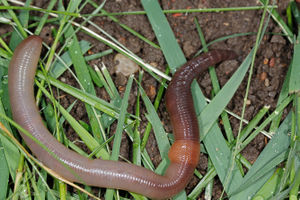
Overview
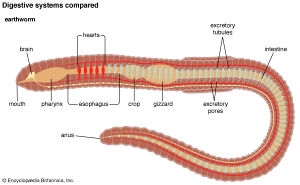
They have a tube within a tube digestive system, with segmentation all along their body, each segment called an annuli. Each external segment has corresponding internal segmentation and setae/bristles to help with movement. They move by contracting and extending circumferential and longitudinal muscles that are in each segment, as well as using the setae on every segment to get a grip. [4]
Earthworms breathe through their skin, and their whole body is covered with a mucous layer that protects from desiccation (i.e. drying out). They have no eyes, instead using cells on the outside of their body that are light sensitive. [4]
They are hermaphrodites, each earthworm exhibiting both male and female sexual organs.
Earthworms live in temperate and tropical soils all over the world, anywhere there is appropriate water content and temperature for at least part of the year. Though, they are most abundant in forests and grasslands of temperate and tropical regions. Earthworm diet includes any organic matter they encounter, like plant matter, fungi, bacteria, or any other organism small enough to be eaten. Their digestive tract is one way, they eat with their mouth on one end and excrete waste at the other end of their body. The same muscles that allow for their movement through soil also push their food through their digestive system. [1][4]
Scientific Classification
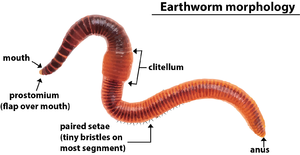
Kingdom - Animalia
Phylum - Annelida
Class - Clitellata
Order - Opisthopora/Haplotaxida
Reproduction
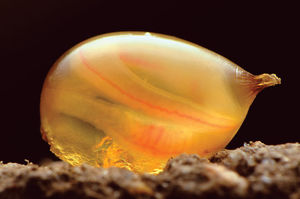
Earthworms can only produce sexually, not asexually. The popular myth that if one cuts an earthworm in half, it will regenerate into two earthworms is false. While earthworms can regenerate small parts of their bodies, they cannot be split into two. Earthworms have both male and female sexual organs, but still need a partner to reproduce. The clitellum is the slightly discolored segment about one-third of the body length away from the head that produces mucous that aids with mating. The worms line up in opposite directions and exchange sperm, using the excreted mucous as a protectant/pathway. The sperm is then stored in sperm sacs and later released along with the eggs into cocoons secreted from the mucous of the clitellum. This forms the lemon-shaped cocoons to the right, which can have one or more embryos inside, depending on the species. New earthworms emerge from these cocoons in a few weeks, depending on the species. [2][5][6]
Earthworm Classification into Subcategories
Earthworms are often classified into a few basic categories, based on morphology, feeding habits, and their microhabitats within the soil. These are called, epigeic, endogeic, and anecic.
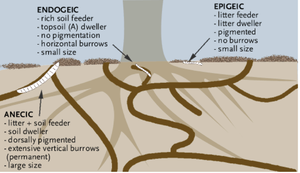
Epigeic Earthworms
Epigeic Earthworms tend to be the smallest of the three, less than 10 cm, and the most pigmented. They live mainly on leaf litter or surface soil and eat litter and small microbes. These worms might make temporary small tunnels through the litter and topsoil. [7]
Endogeic Earthworms
Endogeic Earthworms are moderately sized and unpigmented. They inhabit the mineral level of the soil, ranging from 0-80 cm below ground. Subcategories of endogeic earthworms are: Polyhumic, Mesohumic, Endo-anecic, and Oligohumic. These all inhabit slightly different zones with different organic matter content. [7]
Polyhumic worms live on surface soil or in the root zone and prefer soil with high organic content. They are small-sized, less than 15 cm. They tend to make temporary horizontal burrows. [7]
Mesohumic worms live in soil depths of 0-20 cm and feed on soil from depths of 0-10 cm. These worms make extensive horizontal burrows and are of medium size, 10-20cm. [7]
Endo-Acecic worms live in depths of 0-50 cm, and some make more permanent burrows. They feed on soil from depths of 0-10 cm. They are greater than 20cm in length. [7]
Oligohumic worms live in depths of 15-80 cm and feed on soil from depths of 20-40 cm. They are greater than 20 cm in length and tend to be the largest out of all of these categories. [7]
Anecic Earthworms
These worms live in permanent burrows in the soil. They feed on surface leaf litter that they drag deep into their burrows, as well as soil from any depth they encounter. They are dorsally pigmented (i.e. their back is pigmented) and are greater than 15 cm. [7]
Ecology
Earthworms are ecosystem engineers and play very important roles in soil formation and processes. Some of their largest effects are as a result of their burrows, as well as their digestion of soil and castings. Earthworms of the endogeic and anecic variety make systems of burrows underground, both horizontal and vertical. These burrows, whether temporary or permanent, are a source of aeration for the soil and improve water intake by the soil. [3]
These burrows are also lined with earthworm castings. Casts are made as earthworms ingest mineral soil and/or organic matter, then mix them in the gut. This is mixed with gut secretions from the earthworm that enrich it. As earthworms digest soil, the soil is colonized in the earthworm's gut, by the microbes that live there. When the cast is excreted, the microbes continue to live on in it. This makes earthworm burrows a "hot-spot" for microbial activity, and are thus named the Drilosphere. The earthworms excrete this mixture as either a slurry or separate pellets. These could be within or on top of the soil, depending on the worm category. Earthworm excretions have a high organic matter content, and thus enrich the soil around them and increase fertility. [7] Experiments found that on long-term, no-till soil from the drilosphere, that the soil was enriched in NO3−, NH4+ and soluble organic C. These soils hosted far greater populations of nitrifying and denitrifying bacteria when compared to nondrilosphere soil. [9]
Invasive Earthworms in North America
Much of the land of North America has lacked earthworms since after the last ice age because they could not survive under glaciers. After the last great ice age, the forests and land of North America had adapted to decompose organic matter without the use of earthworms, relying mainly on fungi, bacteria, and time. This led to a thick layer of hummus being present over most forest soils. When the Americas were found by colonizers from Europe and Asia, they brought with them their earthworms. They were likely brought accidentally or on purpose, by bringing plants, dumping their ship ballast, and/or through use as fish bait. Since then, these alien worms have been slowly colonizing more and more of North America and changing soil structure and processes as they do. [7][8]
These introduced worms decompose organic matter at a much faster rate than previously done by fungi and bacteria, which leads to a significantly thinner layer of hummus present. It is not clear yet what the specific effects of this will be, as well as the effects of interactions between alien earthworms and native earthworms(of previously non-glaciated areas). [7]
References
[1] "Earthworm" Wikipedia, Retrieved April 27, 2021, from https://en.wikipedia.org/wiki/Earthworm
[2] "Earthworm" National Geographic, Retrieved April 27, 2021, from https://www.nationalgeographic.com/animals/invertebrates/facts/common-earthworm
[3] Edwards, Clive A. "Earthworms" Natural Resources Conservation Service Soils, USDA, Retrieved April 27, 2021, from https://www.nrcs.usda.gov/wps/portal/nrcs/detailfull/soils/health/biology/?cid=nrcs142p2_053863
[4] "Earthworm Biology – The Science of the Natural Decomposers" BiologyWise, Retrieved April 27, 2021, from https://biologywise.com/earthworm-biology
[5] Painter, Tammie. "How Do Earthworms Reproduce?" Sciencing.com, Retrieved April 27, 2021, from https://sciencing.com/bring-the-outdoors-inside-with-these-nature-kits-for-kids-13763822.html
[6] Clark, Josh. "How Earthworms Work", HowStuffWorks, Retrieved April 27, 2021, from https://animals.howstuffworks.com/animal-facts/earthworm3.htm
[7] Coleman, David C., Callaham, Mac A., Crossley, D. A. "Fundamentals of Soil Ecology", Third Edition, Retrieved from pages 155-168.
[8] "Invasive earthworms in North America" Wikipedia, Retrieved April 28, 2021, from https://en.wikipedia.org/wiki/Invasive_earthworms_of_North_America
[9] Parkin, Timothy B., Berry, Edwin C. "Microbial nitrogen transformations in earthworm burrows" ScienceDirect.com, Retrieved April 29, 2021, from https://doi.org/10.1016/S0038-0717(99)00085-1